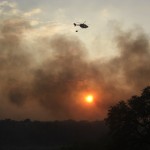How Wildfires Can Reveal Secrets of the Land

Photo by Mose Buchele
Greg Creacy, with Texas Parks and Wildlife, says the wildfires in Bastrop revealed hidden structures and historic roads.
When the Rock House Fire struck Far West Texas in 2011, it didn’t just leave over 300,000 acres of scorched earth in its wake.
It also left bones.
The bleached white bones of wild animals, including the disappearing Pronghorn of the Trans-Pecos, were scattered across the ashes of the high desert, recalls wildlife management graduate student Justin Hoffman. Generations of dead creatures that had previously lain hidden in the tall grass were suddenly revealed, painting a stark picture of how many had died in the previous years from drought and other still-unknown causes.
“Being out here in the field a lot more than I ever have before, you start seeing that the die-off, it’s a lot more significant than I could ever have imagined,” Hoffman says, touring the site of the fire a year later.
And if the image of bones scattered among the West Texas ashes seems like it could have been pulled from the pages of a Cormac McCarthy novel, it’s just one example of how fire can reveal secrets long hidden by the land.

Photo by Mose Buchele for StateImpact Texas.
The Rock House fire of 2011 started at this site outside of Valentine, Texas in April of last year.
“It was amazing what was uncovered by the wildfire,” says Greg Creacy, recalling another fire four months later and nearly 500 miles away, in Bastrop State Park, the site of the historic Labor Day Fires of Central Texas.
Creacy is a natural resources coordinator for Texas Parks and Wildlife. He says the burned out undergrowth revealed hidden historic roads and more throughout the park.
“We were able to see topography that you couldn’t see before,” Creacy remembers. “We found historic Civilian Conservation Corps structures that were not on any records and we didn’t know existed. We’re actively mapping that stuff right now before the regrowing vegetation covers it all up.”
Wildfires have also revealed pre-Colombian archeological sites in California, secret marijuana grow operations in Colorado, and a possible case of animal neglect in Oklahoma. And in some instances, the fires have even pointed the way to better land management practices.
That seems to have been the case back in West Texas, where some of the few remaining living pronghorn were monitored with radio collars in the aftermath of the Rock House fire.
“Even hours after the fire, they never left the burn areas. You can’t help but think that there has to be something out there that kept the animals concentrated on those areas,” says grad student Hoffman. “There has to be some management implication that we can use as biologists to help turn this decline [of the animals] around.”
This is part of a series on the Labor Day wildfires as part of a special project with KUT, Forged in Flames.
On Tuesday, September 4 at 3 p.m., KUT 90.5 FM will air a special one-hour documentary telling the story of the fires. It will air again Wednesday, Sept. 5 at 7 p.m. You can listen on air and online, and stay tuned for more this week.

